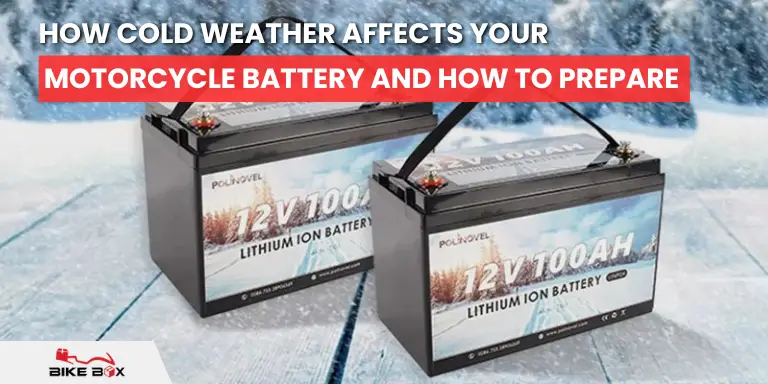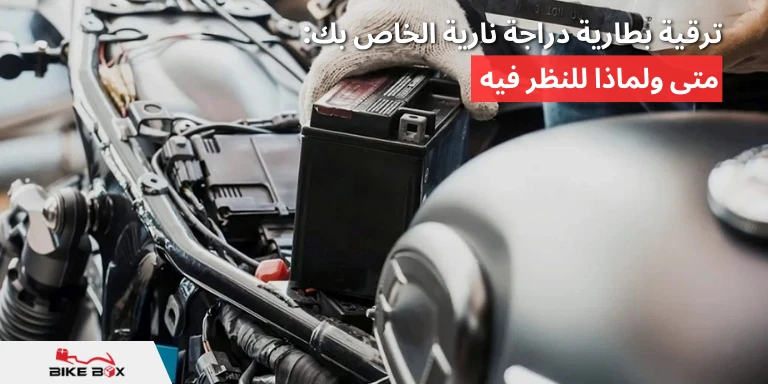We all love the feeling. You are far from home. The engine is running smoothly. This is pure freedom. The quick break is finished. You climb back onto the seat. You press the ignition switch. But instead of a strong engine sound? You hear one small, sad click.thori That is the only noise.
Yes. Your motorcycle battery just failed right now.
This is a very bad feeling when you ride. You feel frustrated right away! But know this secret: getting stuck lasts only a short time if you know what to do. A dead battery happens often. It is not a major disaster.
Bikebox is your emergency instruction manual. We are going to show you how to spot a failing battery before it ruins your day. Then, we will dive into the quick fixes that get you moving. Time to take control of the road!
Common Signs Your Motorcycle Battery Is Failing
Batteries rarely die suddenly. They give you clues first. Spot these early signs of trouble. Then you can avoid getting stranded. Listen to your bike, riders!
1. The Sluggish Start
Does your engine sound tired? You hit the starter. Does the engine turn over slowly? Is it struggling to fire up? That is a major warning sign. You notice this more on cold mornings. Your battery is struggling to deliver the necessary power. Don’t ignore that wum-wum-wum sound.
2. Dim Lights and Weak Horn
Before the engine runs, your battery powers everything. Do your headlights seem dimmer? Does the horn sound like a weak, sad duck instead of an authoritative blast? Low voltage is the culprit. If your turn signals flash slowly, the battery is running on fumes.
3. The Click of Doom
The most dramatic sign. You hear that click-click-click noise? That is the starter trying hard. It just can’t get going. Why? The battery is almost empty. It has no power to crank the engine. It’s totally drained.
4. Crusty Terminals
Give your battery a look (when the bike is cool!). See any fuzzy, blue, or white buildup around the metal posts? That’s terminal corrosion. This stops the electricity flow. It makes the battery seem dead. Even if some charge remains. Look closely at the case. If it looks puffy or swollen, replace it now. Do not wait. It’s failing inside.
5. It’s Just Old!
Motorcycle batteries usually last only 3 to 5 years. Check your records. If the battery is near 4 years old, it’s running out of time. Plan for a replacement soon. It’s smart maintenance!
You can spot the problem. That is important. Now you need the fixes. It has all the detailed solutions. Find it here: Common Motorcycle Battery Problems and How to Fix Them.
Immediate Steps When Your Motorcycle Battery Dies on the Road
Your battery is dead. You’re stopped. Deep breath. Here’s the instant action plan.
1. Safety First, Always!
Your safety is the priority. If traffic is heavy, move your bike fast. Find a safe spot. Turn on your emergency flashers. Wear your safety vest. Make sure drivers see you.
2. The Quick Diagnosis
Take 30 seconds to check the obvious:
- Did you leave the key on? A simple oversight happens!
- Check the terminals. Give the wires a gentle wiggle. Is a connection loose? Tighten it up. Use your tool if you have one. A loose connection mimics a dead battery.
- Is the bike completely dead? If the dash lights or neutral light glow faintly, you have some charge, which means bump-starting might work.
3. Find a Safe Spot
Push your bike if you can. Get off the road. Head for a well-lit spot. A gas station is great. It’s safer to fix your bike there. You need a quiet location.
Quick Ways to Get Your Motorcycle Running Again
Okay, time for the fun part: getting that engine running!
1. The Rider’s Trick: Push-Starting (Bump-Starting)
This works if your battery is weak, but not totally flat. You need just enough power for the spark plugs.
- Setup: Key on. Switch the bike into second or third gear. Clutch in.
- The Run: Get a running start. Push the bike up to a decent jog (about 5-10 mph). You need momentum!
- The Drop: When you’re running fast enough, hop on. Quickly release the clutch while opening the throttle slightly. The sudden movement turns the engine over.
- Clutch In! Engine starts? Great! Pull that clutch in fast. Gently feed it throttle. Don’t let it die! Now, ride steadily for 30 minutes. This gives the alternator time to recharge.
2. Jump-Starting: The Safe Way
Get power from a car or a friend’s bike. Jump-starting is possible. Be careful, though! Don’t mess up your wiring. You do not want to fry your electronics.
- Donor Vehicle: If you use a car, the car engine MUST be OFF. A running car can deliver too much voltage.
- Cables and Grounding:
- Red cable to positive (+) on both batteries.
- Black cable to negative (-) on the donor battery.
- The final black cable clamp goes to a solid, unpainted metal spot on your bike’s frame. This is your safe grounding point, away from the battery and fuel.
- Start Up: Try the ignition now. Did the engine start? Great! Disconnect the cables. Do this in reverse order. Frame first. Then the donor negative. Next, the donor positive. Finish with your positive cable.
3. The Modern Solution: Portable Jump Starter
Forget those bulky cables. The modern choice is a compact lithium jump starter. This tool is amazing on the road. It is small and super safe. It prevents sparks and damage. Add this to your kit today. This investment pays for itself.
What to Do After You Get Home (Long-Term Fixes)
You made it! But the mission isn’t over. Riding the bike home is not a fix. You need to address the real problem.
1. Full Charge and Testing
Put the battery on a smart charger. Do not use a cheap one. These tenders protect your battery. They stop damage from overcharging. Leave it plugged in overnight.
The next day, unplug the battery. Use your voltmeter. It is time to check the voltage level.
- Healthy Battery: Should be around 12.6 to 12.8 volts.
- Failing Battery: If it drops below 12.4 volts after a few hours, it is replacement time.
Pro-Tip: Battery care is crucial. It ensures long-term performance. Want to master maintenance? Read our guide. It will boost your bike’s power: The Ultimate Motorcycle Battery Guide 2025: Boost Your Bike’s Performance.
2. Check the Charging System
Sometimes the battery is just a symptom. The real issue might be a failing charging system.
- Voltage Check: Start the engine. Run it near 2,000 RPM. Check the voltage again. It should read 13.5 to 14.5 volts. Is the number too low? Your stator is bad. Is it too high? Your regulator is damaging the battery.
3. Get the Right Parts
If testing confirms your battery is truly done, don’t buy the cheapest option. A great bike deserves quality components.
When you need reliable motorcycle spare parts, especially high-quality original spare parts, Bikebox is here to help. We understand that riders need dependable new spare parts quickly. We make it easy to buy original spare parts online, ensuring your bike gets the best. Especially in tough riding conditions, like needing reliable spare parts in Saudi Arabia, quality matters most.
We supply a huge range of motorcycle spare parts and accessories. We have everything you need. This keeps your bike running perfectly.
Essential Tools and Gear to Carry for Battery Emergencies
The best defense? Being prepared! Keep a small kit with you. It means you can fix almost any emergency.
| Item | Why It’s a Lifesaver |
| Compact Jump Starter | Quick, safe power boost without needing another vehicle. |
| Basic Wrench/Socket Set | Essential for tightening loose battery terminal bolts. |
| Small Digital Multimeter | The only way to know your battery voltage and charging system health. |
| Mini LED Headlamp | Keep your hands clear. It is vital for dark conditions. |
| Gloves | Protects your hands from dirt and corrosion. |
Ride On, Worry Less
A dead battery happens often. It is not a disaster. Watch for the warning signs. Know the bump-start tricks. Learn the jump-start method. You can fix this problem fast.
Your bike needs good parts to run. Reliability depends on quality. Always choose the best when replacing parts. Need great motorcycle spare parts and accessories? Trust Bikebox. We keep your wheels safe. We keep them turning reliably.
Be smart when you ride. Stay fully charged up. Now go hit the open road!
FAQs
What is the average lifespan of a motorcycle battery?
Your battery should last 3 to 5 years. Keep it charged often. Proper maintenance is important. This helps you use it for the longest time.
How long should I ride to recharge a dead battery?
Ride for at least 30 minutes. Keep a steady speed. This gives the alternator time. It needs to properly restore the charge.
What does the “Click of Doom” mean when I try to start my bike?
The battery is almost dead. It has a critically low charge. The solenoid is still engaging. But there is no power left. It cannot turn the engine over.
Where can I find high-quality original spare parts for my motorcycle?
Choose only trusted dealers. Pick ones who sell quality parts. For reliable motorcycle spare parts and accessories, go to Bikebox.
What voltage should a fully charged motorcycle battery read?
Your battery is fully charged. The voltage should be 12.6 to 12.8 volts. Check this while it rests. Does the voltage drop fast? If it hits below 12.4 volts? You probably need a new one.



